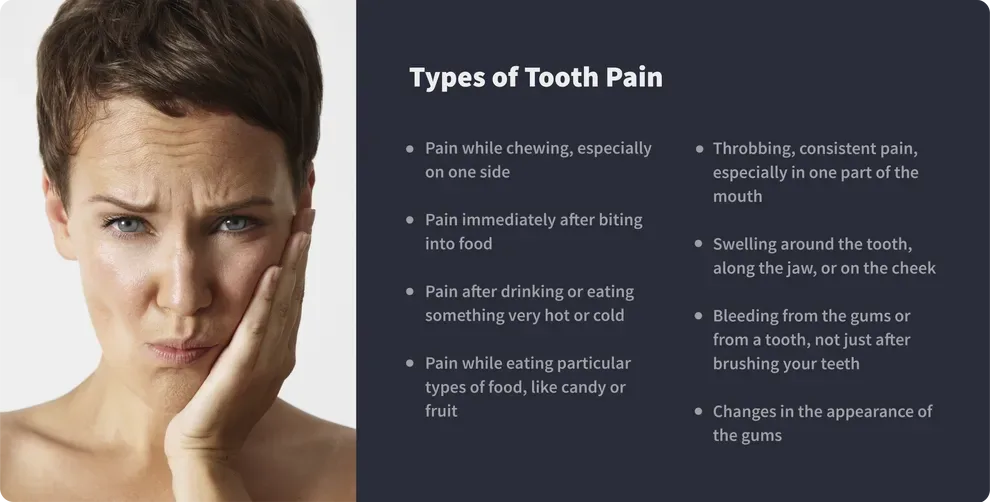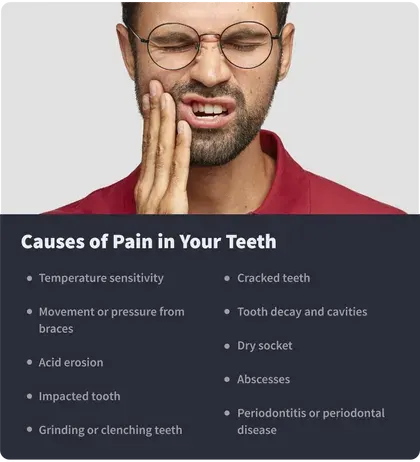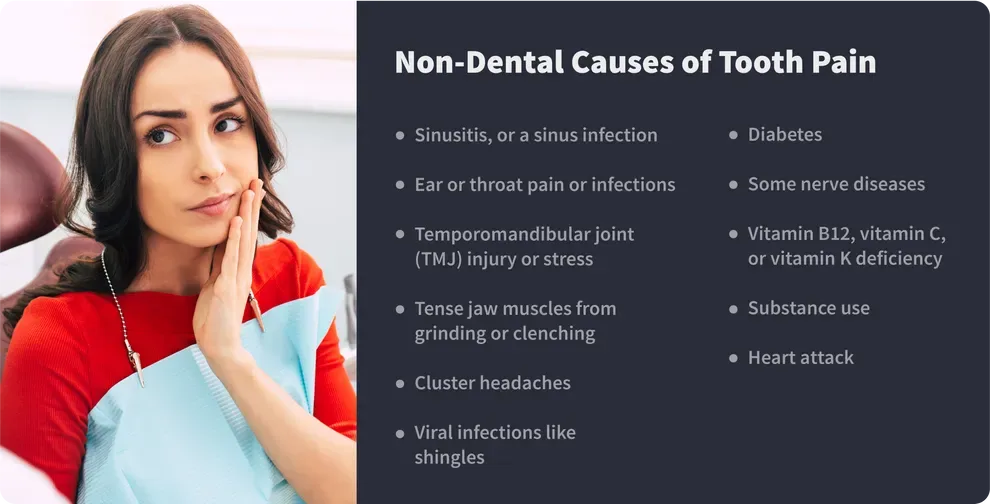Teeth Hurt? Causes & Solutions for Oral Pain

Table of Contents
- Dental Causes
- Non-Dental Causes
- Home Remedies
- Talk to Your Dentist
- References
Pain in or around the teeth is a common experience, but it can be disturbing when it occurs. The pain can mean you have a cavity, a cracked filling, or something worse.
Although pain in your teeth may mean that you need to visit your dentist, there are several reasons for dental discomfort that are easy to fix, especially if you get it looked at right away. Unfortunately, many people ignore tooth pain early on, particularly when the pain comes and goes, or it can be alleviated with home remedies. This can make complications like broken teeth or gum disease worse over time.

The term “tooth pain” can refer to several sensations, including:
Pain while chewing, especially on one side.
Pain immediately after biting into food.
Pain after drinking or eating something very hot or cold.
Pain while eating particular types of food, like candy or fruit.
Throbbing, consistent pain, especially in one part of the mouth.
Swelling around the tooth, along the jaw, or on the cheek.
Bleeding from the gums or from a tooth, not just after brushing your teeth.
Changes in the appearance of the gums.
Many of these symptoms are associated with gingival or periodontal disease, meaning the gums, roots, dentin, or other parts of your mouth are infected.1 These infections are simple to take care of when diagnosed early or when caught during a regular dental exam. However, if they are not treated, they can cause long-term damage to your overall oral health.
Dental Causes of Pain in Your Teeth

Toothaches have several potential causes, many of which require dental treatment. However, not all treatment needs to be immediate, depending on the cause of pain.
This is one of the most commonly reported types of tooth pain or discomfort. Sensitivity to hot or cold foods and drinks can be normal if you have thin enamel. If the sensitivity is new, this could indicate slightly recessed gums, mild infection, or a cracked tooth. If it gets worse or the pain lingers, report the problem to your dentist sooner.
If you have recently had dental work done, like getting a filling, this could have inflamed the dentin (the pulp inside your tooth), so it is reacting to stimuli. If this does not go away within a day or two, or it gets worse, contact your dentist.
If you have an orthodontic appliance like traditional braces or clear aligners, your teeth may hurt due to the consistent pressure. This is a normal part of the process, and you will typically get used to it as your teeth adjust.
If the pain becomes worse rather than better or suddenly becomes sharper, ask your dentist for help. They will be able to adjust the appliance or fix any underlying problem.
Acidic food and drink increase the natural acidity in the mouth, which can erode your enamel. Over time, this can increase the risk of cavities or cracks, which expose the dentin or roots of your teeth and cause pain.
Adjust your diet so you consume less acidic food. Add baking soda to your nightly oral care routine. Baking soda is basic, so it will move the pH of your mouth closer to neutral. And try using some types of repair toothpastes. Your dentist can recommend further specific steps.
Signs of an impacted tooth, which has not ruptured the surface of the gums yet, include painful swelling of the gums, soreness, and throbbing in surrounding teeth. Any adult tooth that comes in might become impacted.
This is often a problem with wisdom teeth, which come in later in the teenage years or in young adulthood. It is important to get wisdom teeth removed when they start coming in unless your dentist says otherwise.
Called bruxism, this is a problem associated with stress. You may not realize you are grinding or clenching your teeth during the day. Even if you adjust your jaw while you are awake, you may experience bruxism while you sleep. This can cause damage to your teeth and gums.
Your dentist will likely notice these problems during a routine visit, especially if you report pain in certain teeth. Common treatments are stress relief exercises and bite guards, especially to manage bruxism at night.
Teeth that have cracks from an impact trauma, bruxism, damaged fillings or crowns, or damaged enamel can expose the internal parts of your tooth, like the dentin and the root. This exposure will cause pain. Some types of trauma or infection that creeps in due to exposure can also hurt the gums, leading to more pain.
Enamel can be worn away or parts of your tooth exposed as gums recede, leading to infection that causes cavities (or dental caries) and tooth decay.3 This is an infection in one or two specific teeth, which gets into the root and causes pain.
Tooth decay can lead to other types of infection like gingivitis or periodontitis, but it can also be diagnosed as the only cause of tooth pain.
This is a specific type of infection in the roots and gums where a tooth has been removed. Teenagers and adults are most at risk of dry socket after having wisdom teeth removed, but this infection can occur if you have other teeth removed.
An infection that remains untreated can form an abscess, or a pocket of infection, that can swell, leak pus, put pressure on the surrounding tissue, damage or shift your teeth, and even cause an infection in the jaw, surrounding bone, or cheek. You will need to see an endodontist to treat the infection.
Untreated gingivitis can lead to worsening gum disease, called periodontitis. Unfortunately, gingivitis does not typically cause pain. Your gums may bleed easily, look red rather than pink, and begin to recede away from your teeth, but few people notice or seek treatment for these symptoms.
Periodontitis can cause pain in the roots of the teeth, especially if teeth become loose and cannot bite into food correctly. The infection can also spread to the jaw, which will become painful.
Non-Dental Causes of Tooth Pain
Although there are several oral health problems with tooth pain as a main symptom, there are other health problems that may cause pain in your teeth or jaw.
Sinusitis, or a sinus infection
Ear or throat pain or infections
Temporomandibular joint (TMJ) injury or stress
Tense jaw muscles from grinding or clenching
Cluster headaches
Viral infections like shingles
Diabetes
Some nerve diseases
Vitamin B12, vitamin C, or vitamin K deficiency
Substance use
Heart attack
Going to regular dental appointments can lower your risk of more severe problems associated with tooth pain.

Home Remedies for Your Teeth Hurting
If you have tooth pain and need to wait for a few hours or days for your dentist appointment, there are some remedies you can try at home to ease the pain. It is important not to use these instead of visiting your dentist for diagnosis and treatment because tooth pain can indicate an infection or trauma that needs medical treatment.
Take over-the-counter pain medication like ibuprofen or acetaminophen.
Place a warm or cold compress on your face.
Drink a warm herbal tea like peppermint or chamomile.
Prop yourself up to sleep at night, which helps to alleviate pressure on your face as you sleep.
Avoid chewing on the side that hurts, and eat softer foods.
Get a toothbrush with extra soft bristles to gently brush the painful area.
Tell Your Dentist if Your Teeth Hurt
Depending on the cause of your tooth pain, your dentist may fill a cavity or cover a crack in your tooth, perform a root canal, remove a tooth, prescribe antibiotics, and create a long-term course of treatment.
Regular visits to your dentist can help to prevent many sources of tooth pain. Your dentist can also give you consistent recommendations to reduce the risk of infection, like specific toothbrushes or toothpastes and even orthodontic treatment.
